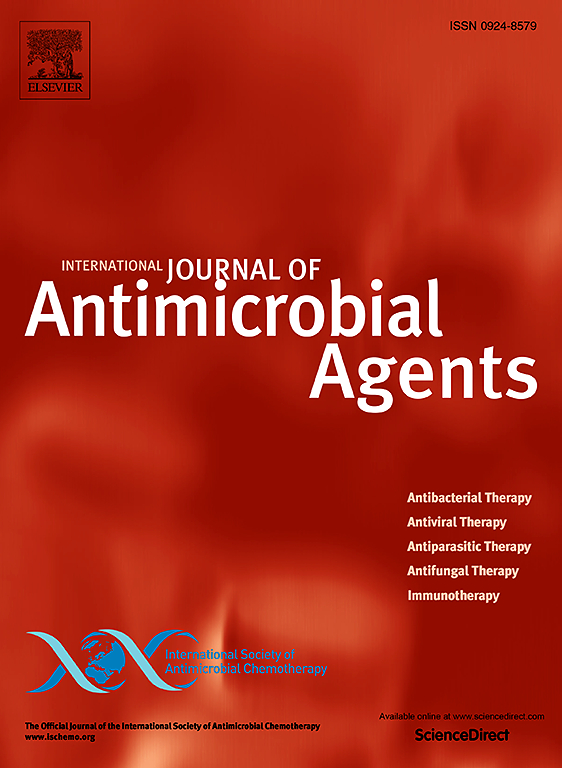肯尼亚内罗毕南部Dagoretti地区儿童、牲畜和食品中致腹泻的耐药大肠杆菌的流行病学
IF 4.9
2区 医学
Q1 INFECTIOUS DISEASES
International Journal of Antimicrobial Agents
Pub Date : 2024-12-24
DOI:10.1016/j.ijantimicag.2024.107419
引用次数: 0
摘要
人口密集、牲畜同居、食物系统复杂的城市周边环境是食品污染和传染病的热点。6-24个月的儿童尤其脆弱,因为他们经常接触受污染的食物和水,增加了他们患食源性疾病的风险,腹泻是一种常见症状。我们调查了肯尼亚内罗毕Dagoretti南亚县6-24个月大的儿童、他们的食物和同居牲畜中致病性大肠杆菌的抗微生物药物耐药性(AMR)的流行情况。在585户随机收集的540份粪便、296份牲畜粪便和859份食品样本中,16%携带致泻性大肠杆菌(DEC)病原。观察到的主要AMR表型为甲氧苄啶-磺胺甲恶唑,氨苄西林和四环素,分别为53%,48%和41%。与来自牲畜和食物的致泻性大肠杆菌相比,来自儿童的大肠杆菌对所有抗生素的耐药性都要高得多。总体而言,来自所有三个来源的274株DEC分离株中有30%表现出多药耐药。AMR共发生的网络分析显示:氨苄西林、甲氧苄氨嘧啶-磺胺甲恶唑、四环素、阿莫西林/克拉维酸和氯霉素;萘啶酸、环丙沙星、庆大霉素和头孢曲松。儿童分离株氨苄西林-甲氧苄啶/磺胺甲氧苄唑-四环素共耐药主干明显高于其他宿主(χ² = 29.858,df = 2,调整后p < 0.05)。Logistic回归分析显示,动物粪便和垃圾的现场处理以及近期腹泻史与儿童AMR携带显著相关(p < 0.05)。这些发现强调需要采取“同一个健康”干预措施,以遏制这些密切接触人群中抗菌素耐药性的出现和传播。本文章由计算机程序翻译,如有差异,请以英文原文为准。
Epidemiology of Antimicrobial-Resistant Diarrheagenic Escherichia coli Pathotypes From Children, Livestock and Food in Dagoretti South, Nairobi Kenya
Peri-urban environments, characterized by dense human populations, cohabiting livestock, and complex food systems, serve as hotspots for food contamination and infectious diseases. Children aged 6–24 months are particularly vulnerable, as they often encounter contaminated food and water, increasing their risk of food-borne disease, with diarrhea being a common symptom. We investigated the prevalence of antimicrobial resistance (AMR) in pathogenic Escherichia coli from children 6–24 months of age, their food, and cohabiting livestock, in Dagoretti South subcounty in Nairobi, Kenya. Of 540 stools, 296 livestock feces, and 859 food samples collected from 585 randomly enrolled households, 16% harbored diarrheagenic E. coli (DEC) pathotypes. The predominant AMR phenotypes observed were trimethoprim–sulfamethoxazole, ampicillin, and tetracycline at 53%, 48% and 41%, respectively. Diarrheagenic E. coli from children showed significantly higher resistance to all antibiotics compared to those from livestock and food. Overall, 30% of the 274 DEC isolates from all three sources exhibited multidrug resistance. Network analysis of AMR co-occurrence revealed two clusters: (1) ampicillin, trimethoprim–sulfamethoxazole, tetracycline, amoxicillin/clavulanic acid, and chloramphenicol; and (2) nalidixic acid, ciprofloxacin, gentamicin, and ceftriaxone. The co-resistance backbone of ampicillin–trimethoprim/sulfamethoxazole–tetracycline was significantly higher among isolates from children than from other hosts (χ² = 29.858, df = 2, adjusted P < 0.05). Logistic regression analysis revealed that on-site disposal of animal manure and garbage, along with a recent history of diarrhea, were significantly associated with AMR carriage in children (P < 0.05). These findings emphasize the need for One Health interventions to curb emergence and spread of AMR in these close-contact populations.
求助全文
通过发布文献求助,成功后即可免费获取论文全文。
去求助
来源期刊
CiteScore
21.60
自引率
0.90%
发文量
176
审稿时长
36 days
期刊介绍:
The International Journal of Antimicrobial Agents is a peer-reviewed publication offering comprehensive and current reference information on the physical, pharmacological, in vitro, and clinical properties of individual antimicrobial agents, covering antiviral, antiparasitic, antibacterial, and antifungal agents. The journal not only communicates new trends and developments through authoritative review articles but also addresses the critical issue of antimicrobial resistance, both in hospital and community settings. Published content includes solicited reviews by leading experts and high-quality original research papers in the specified fields.

 求助内容:
求助内容: 应助结果提醒方式:
应助结果提醒方式:


